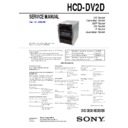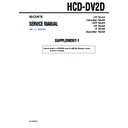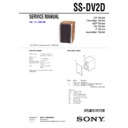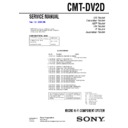Read Sony CMT-DV2D / HCD-DV2D Service Manual online
SERVICE MANUAL
Sony Corporation
Audio&Video Business Group
Published by Sony Techno Create Corporation
Published by Sony Techno Create Corporation
US Model
Canadian Model
AEP Model
UK Model
E Model
Australian Model
DVD DECK RECEIVER
9-879-536-07
2008I16-1
© 2008.09
© 2008.09
Ver. 1.6 2008.09
SPECIFICATIONS
HCD-DV2D
HCD-DV2D is the Amplifier, DVD player, Tape
Deck and Tuner section in CMT-DV2D.
Deck and Tuner section in CMT-DV2D.
DVD
Model Name Using Similar Mechanism
HCD-GP8D
Section
DVD Mechanism Type
KDA898ST
Traverse Mechanism Name
1ADOMEZ0412
TAPE
Model Name Using Similar Mechanism
NEW
Section
Tape Transport Mechanism Type
CMAL5Z220C
— Continued on next page —
This system incorporates Dolby
1)
Digital and DTS
2)
Digital
Surround System.
1)
Manufactured under license from Dolby Laboratories.
“Dolby”, “Pro Logic”, and the double-D symbol are trademarks
of Dolby Laboratories.
of Dolby Laboratories.
2)
Manufactured under license from Digital Theater Systems,
Inc. “DTS” and “DTS 2.0 + Digital Out” are trademarks of
Digital Theater Systems, Inc.
Digital Theater Systems, Inc.
Amplifier section
AUDIO POWER SPECIFICATIONS
(USA model only)
(USA model only)
POWER OUTPUT AND TOTAL HARMONIC
DISTORTION:
DISTORTION:
With 6 ohm loads, both channels driven, from
120 – 10,000 Hz: rated 50 watts per channel
minimum RMS power, with no more than 10%
total harmonic distortion from 250 milliwatts to
rated output.
120 – 10,000 Hz: rated 50 watts per channel
minimum RMS power, with no more than 10%
total harmonic distortion from 250 milliwatts to
rated output.
North American model:
Front speaker
Continuous RMS power output (reference):
Continuous RMS power output (reference):
50 + 50 watts (6 ohms at
1 kHz, 10% THD)
1 kHz, 10% THD)
Total harmonic distortion less than 0.07% (6 ohms at
1 kHz, 25 W)
European and Russian models:
DIN power output (rated): 40 + 40 watts (6 ohms at
1 kHz, DIN)
Continuous RMS power output (reference):
50 + 50 watts (6 ohms at
1 kHz, 10% THD)
1 kHz, 10% THD)
Music power output (reference):
100 + 100 watts (6 ohms at
1 kHz, 10% THD)
1 kHz, 10% THD)
Korean model:
The following measured at AC 220 V, 60 Hz
DIN power output (rated) 35 + 35 watts
DIN power output (rated) 35 + 35 watts
(6 ohms at 1 kHz, DIN)
Continuous RMS power output (reference)
45 + 45 watts
(6 ohms at 1 kHz, 10%
THD)
(6 ohms at 1 kHz, 10%
THD)
Other models:
The following measured at AC 120 V, 240 V, 50/60 Hz
DIN power output (rated) 40 + 40 watts
DIN power output (rated) 40 + 40 watts
(6 ohms at 1 kHz, DIN)
Continuous RMS power output (reference)
50 + 50 watts
(6 ohms at 1 kHz, 10%
THD)
(6 ohms at 1 kHz, 10%
THD)
Inputs
TV IN (phono jacks):
TV IN (phono jacks):
voltage 1 V,
impedance 47 kilohms
impedance 47 kilohms
Outputs
VIDEO OUT (phono jack) (except for European and
Russian models):
VIDEO OUT (phono jack) (except for European and
Russian models):
max. output level
1 Vp-p, unbalanced, Sync
negative, load impedance
75 ohms
1 Vp-p, unbalanced, Sync
negative, load impedance
75 ohms
LINE-TV (European and Russian models only):
max. output level 1 Vp-p,
unbalanced, Sync
negative, load impedance
75 ohms
unbalanced, Sync
negative, load impedance
75 ohms
DIGITAL OUT (OPTICAL) (Square optical connector
jack, rear panel)
Wavelength
jack, rear panel)
Wavelength
660 nm
PHONES (stereo mini jack):
accepts headphones of
8 ohms or more
8 ohms or more
SPEAKER:
accepts impedance of
6 ohms
6 ohms
Disc player section
System
Compact disc and digital
audio and video system
audio and video system
Laser
Semiconductor laser
(DVD:
(DVD:
λ=650 nm,
CD:
λ=780 nm)
Emission duration:
continuous
continuous
Frequency response
DVD (PCM 48 kHz):
2 Hz – 22 kHz (
2 Hz – 22 kHz (
±
1 dB)
CD: 2 Hz – 20 kHz (
±
1 dB)
Video color system format
Pan-American models:
NTSC
European and Russian
models: PAL
Other models: NTSC, PAL
NTSC
European and Russian
models: PAL
Other models: NTSC, PAL
2
HCD-DV2D
SAFETY CHECK-OUT
After correcting the original service problem, perform the following
safety check before releasing the set to the customer:
Check the antenna terminals, metal trim, “metallized” knobs, screws,
and all other exposed metal parts for AC leakage.
Check leakage as described below.
safety check before releasing the set to the customer:
Check the antenna terminals, metal trim, “metallized” knobs, screws,
and all other exposed metal parts for AC leakage.
Check leakage as described below.
LEAKAGE TEST
The AC leakage from any exposed metal part to earth ground and
from all exposed metal parts to any exposed metal part having a
return to chassis, must not exceed 0.5 mA (500 microamperes.).
Leakage current can be measured by any one of three methods.
from all exposed metal parts to any exposed metal part having a
return to chassis, must not exceed 0.5 mA (500 microamperes.).
Leakage current can be measured by any one of three methods.
1. A commercial leakage tester, such as the Simpson 229 or RCA
WT-540A. Follow the manufacturers’ instructions to use these
instruments.
instruments.
2. A battery-operated AC milliammeter. The Data Precision 245
digital multimeter is suitable for this job.
3. Measuring the voltage drop across a resistor by means of a
VOM or battery-operated AC voltmeter. The “limit” indication
is 0.75 V, so analog meters must have an accurate low-voltage
scale. The Simpson 250 and Sanwa SH-63Trd are examples
of a passive VOM that is suitable. Nearly all battery operated
digital multimeters that have a 2 V AC range are suitable. (See
Fig. A)
is 0.75 V, so analog meters must have an accurate low-voltage
scale. The Simpson 250 and Sanwa SH-63Trd are examples
of a passive VOM that is suitable. Nearly all battery operated
digital multimeters that have a 2 V AC range are suitable. (See
Fig. A)
Fig. A.
Using an AC voltmeter to check AC leakage.
1.5 k
Ω
0.15
µ
F
AC
voltmeter
(0.75 V)
voltmeter
(0.75 V)
To Exposed Metal
Parts on Set
Parts on Set
Earth Ground
SAFETY-RELATED COMPONENT WARNING!!
COMPONENTS IDENTIFIED BY MARK
0
OR DOTTED LINE
WITH MARK
0
ON THE SCHEMATIC DIAGRAMS AND IN
THE PARTS LIST ARE CRITICAL TO SAFE OPERATION.
REPLACE THESE COMPONENTS WITH SONY PARTS WHOSE
PART NUMBERS APPEAR AS SHOWN IN THIS MANUAL OR
IN SUPPLEMENTS PUBLISHED BY SONY.
REPLACE THESE COMPONENTS WITH SONY PARTS WHOSE
PART NUMBERS APPEAR AS SHOWN IN THIS MANUAL OR
IN SUPPLEMENTS PUBLISHED BY SONY.
ATTENTION AU COMPOSANT AYANT RAPPORT
À LA SÉCURITÉ!
LES COMPOSANTS IDENTIFIÉS PAR UNE MARQUE
0
SUR
LES DIAGRAMMES SCHÉMATIQUES ET LA LISTE DES
PIÈCES SONT CRITIQUES POUR LA SÉCURITÉ DE
FONCTIONNEMENT. NE REMPLACER CES COM- POSANTS
QUE PAR DES PIÈCES SONY DONT LES NUMÉROS SONT
DONNÉS DANS CE MANUEL OU DANS LES SUPPLÉMENTS
PUBLIÉS PAR SONY.
PIÈCES SONT CRITIQUES POUR LA SÉCURITÉ DE
FONCTIONNEMENT. NE REMPLACER CES COM- POSANTS
QUE PAR DES PIÈCES SONY DONT LES NUMÉROS SONT
DONNÉS DANS CE MANUEL OU DANS LES SUPPLÉMENTS
PUBLIÉS PAR SONY.
Tape deck section
Recording system
4-track 2-channel stereo
Frequency response
40 – 13,000 Hz,
using Sony TYPE I
cassette
using Sony TYPE I
cassette
Tuner section
FM stereo, FM/AM superheterodyne tuner
FM tuner section
Tuning range
87.5 – 108.0 MHz
(50 kHz step)
(50 kHz step)
Antenna
FM lead antenna
Antenna terminals
75 ohms unbalanced
Intermediate frequency
10.7 MHz
AM tuner section
Tuning range
Pan-American models:
Pan-American models:
530 – 1,710 kHz
(with the tuning interval
set at 10 kHz)
531 – 1,710 kHz
(with the tuning interval
set at 9 kHz)
(with the tuning interval
set at 10 kHz)
531 – 1,710 kHz
(with the tuning interval
set at 9 kHz)
European and Russian models:
531 – 1,602 kHz
(with the interval set at
9 kHz)
(with the interval set at
9 kHz)
Other models:
530 – 1,710 kHz
(with the interval set at
10 kHz)
531 – 1,602 kHz
(with the interval set at
9 kHz)
(with the interval set at
10 kHz)
531 – 1,602 kHz
(with the interval set at
9 kHz)
Antenna
AM loop antenna
Antenna terminals
External antenna terminal
Intermediate frequency
450 kHz
General
Power requirements
North American model:
North American model:
120 V AC, 60 Hz
European and Russian models:
230 V AC, 50/60 Hz
Australian model:
230 – 240 V AC, 50/60 Hz
Taiwan model:
120 V AC, 50/60 Hz
Korean model:
220 V AC, 60 Hz
Other models:
110 – 120 V, 220 – 240 V
AC, 50/60 Hz
Adjustable with voltage
selector
AC, 50/60 Hz
Adjustable with voltage
selector
Power consumption
USA model:
USA model:
110 watts
Canadian model:
110 watts
European and Russian models:
110 watts
0.3 watts (in Power Saving
mode)
0.3 watts (in Power Saving
mode)
Other models:
120 watts
Dimensions (w/h/d) (excl. speakers)
Approx. 191
×
255
×
310 mm
Mass (excl. speakers)
Approx. 6.5 kg
Design and specifications are subject to change
without notice.
without notice.
Ver 1.2
3
HCD-DV2D
CAUTION
Use of controls or adjustments or performance of procedures
other than those specified herein may result in hazardous radiation
exposure.
other than those specified herein may result in hazardous radiation
exposure.
UNLEADED SOLDER
Boards requiring use of unleaded solder are printed with the lead-
free mark (LF) indicating the solder contains no lead.
(Caution: Some printed circuit boards may not come printed with
free mark (LF) indicating the solder contains no lead.
(Caution: Some printed circuit boards may not come printed with
the lead free mark due to their particular size)
: LEAD FREE MARK
Unleaded solder has the following characteristics.
•
Unleaded solder melts at a temperature about 40
°
C higher
than ordinary solder.
Ordinary soldering irons can be used but the iron tip has to be
applied to the solder joint for a slightly longer time.
Soldering irons using a temperature regulator should be set to
about 350
Ordinary soldering irons can be used but the iron tip has to be
applied to the solder joint for a slightly longer time.
Soldering irons using a temperature regulator should be set to
about 350
°
C.
Caution: The printed pattern (copper foil) may peel away if
the heated tip is applied for too long, so be careful!
•
Strong viscosity
Unleaded solder is more viscou-s (sticky, less prone to flow)
than ordinary solder so use caution not to let solder bridges
occur such as on IC pins, etc.
Unleaded solder is more viscou-s (sticky, less prone to flow)
than ordinary solder so use caution not to let solder bridges
occur such as on IC pins, etc.
•
Usable with ordinary solder
It is best to use only unleaded solder but unleaded solder may
also be added to ordinary solder.
It is best to use only unleaded solder but unleaded solder may
also be added to ordinary solder.
Notes on chip component replacement
•
Never reuse a disconnected chip component.
•
Notice that the minus side of a tantalum capacitor may be
damaged by heat.
damaged by heat.
Flexible Circuit Board Repairing
•
Keep the temperature of the soldering iron around 270
°
C
during repairing.
•
Do not touch the soldering iron on the same conductor of the
circuit board (within 3 times).
circuit board (within 3 times).
•
Be careful not to apply force on the conductor when soldering
or unsoldering.
or unsoldering.
Laser component in this product is capable of emitting radiation
exceeding the limit for Class 1.
exceeding the limit for Class 1.
This appliance is classified as
a CLASS 1 LASER product.
The CLASS 1 LASER
PRODUCT MARKING is
located on the rear exterior.
a CLASS 1 LASER product.
The CLASS 1 LASER
PRODUCT MARKING is
located on the rear exterior.
TABLE OF CONTENTS
1.
SERVICING NOTES
................................................
4
2.
GENERAL
...................................................................
5
3.
DISASSEMBLY
3-1.
Disassembly Flow ...........................................................
8
3-2.
Cover Top, DC Fan ..........................................................
9
3-3.
AMP Board, AV Board, Tuner (FM/AM) .......................
9
3-4.
MPEG Board ................................................................... 10
3-5.
DVD Mech Cover A/B .................................................... 10
3-6.
Panel (DVD) .................................................................... 11
3-7.
DVD Loader (KDA898ST) ............................................. 11
3-8.
Front Panel Section ......................................................... 12
3-9.
MAIN Board .................................................................... 12
3-10. Cassette Deck Mechanism (CMAL5Z220C) .................. 13
3-11. KEY Board ...................................................................... 13
3-12. Traverse Mech (1ADOMEZ0412) .................................. 14
3-13. Lid TC ............................................................................. 14
3-11. KEY Board ...................................................................... 13
3-12. Traverse Mech (1ADOMEZ0412) .................................. 14
3-13. Lid TC ............................................................................. 14
4.
TEST MODE
............................................................... 15
5.
MECHANICAL ADJUSTMENTS
......................... 19
6.
ELECTRICAL ADJUSTMENTS
.......................... 19
7.
DIAGRAMS
7-1.
Block Diagrams — MPEG-1 Section — ....................... 22
— MPEG-2 Section — .................................................... 23
— AUDIO Section — ...................................................... 24
— PANEL/POWER Section — ...................................... 25
— MPEG-2 Section — .................................................... 23
— AUDIO Section — ...................................................... 24
— PANEL/POWER Section — ...................................... 25
7-2.
Printed Wiring Board — MAIN Section-1 — ................ 26
7-3.
Printed Wiring Board — MAIN Section-2 — ................ 27
7-4.
Schematic Diagram — MAIN Section — ...................... 28
7-5.
Printed Wiring Board — MPEG Section-1 — ............... 29
7-6.
Printed Wiring Board — MPEG Section-2 — ............... 30
7-7.
Schematic Diagram — MPEG Section — ..................... 31
7-8.
Printed Wiring Board — KEY Section — ..................... 32
7-9.
Schematic Diagram — KEY Section — ........................ 33
7-10. Printed Wiring Board — AV Section — ......................... 34
7-11. Schematic Diagram — AV Section — ........................... 35
7-12. Printed Wiring Board — AMP,
7-11. Schematic Diagram — AV Section — ........................... 35
7-12. Printed Wiring Board — AMP,
POWER(EXCEPT AEP, UK, RU, KR, AUS) Section — 36
7-13. Schematic Diagram — AMP Section — ........................ 37
7-14. Schematic Diagram — POWER Section
7-14. Schematic Diagram — POWER Section
(E2, E3, E51, SP, TW Model) — .................................... 38
7-15. Schematic Diagram — POWER Section
(US, CND Model) — ...................................................... 39
8.
EXPLODED VIEWS
8-1.
Overall Section ................................................................ 54
8-2.
Front Panel Section ......................................................... 55
8-3.
Chassis Section ................................................................ 56
8-4.
DVD Mechanism Deck Section ...................................... 57
9.
ELECTRICAL PARTS LIST
.................................. 58
•
Abbreviation
AUS : Australian model.
CND : Canadian model.
E2
AUS : Australian model.
CND : Canadian model.
E2
: 120 V AC area in E model.
E3
: 240 V AC area in E model.
E51 : Chilean and Peruvian model.
KR : Korea model.
RU : Russian model.
SP
KR : Korea model.
RU : Russian model.
SP
: Singapore model.
TW : Taiwan model.
Ver. 1.2
4
HCD-DV2D
SECTION 1
SERVICING NOTES
The laser diode in the optical pick-up block may suffer electrostatic
break-down because of the potential difference generated by the
charged electrostatic load, etc. on clothing and the human body.
During repair, pay attention to electrostatic break-down and also
use the procedure in the printed matter which is included in the
repair parts.
The flexible board is easily damaged and should be handled with
care.
break-down because of the potential difference generated by the
charged electrostatic load, etc. on clothing and the human body.
During repair, pay attention to electrostatic break-down and also
use the procedure in the printed matter which is included in the
repair parts.
The flexible board is easily damaged and should be handled with
care.
NOTES ON LASER DIODE EMISSION CHECK
The laser beam on this model is concentrated so as to be focused on
the disc reflective surface by the objective lens in the optical pick-
up block. Therefore, when checking the laser diode emission,
observe from more than 30 cm away from the objective lens.
the disc reflective surface by the objective lens in the optical pick-
up block. Therefore, when checking the laser diode emission,
observe from more than 30 cm away from the objective lens.
LASER DIODE AND FOCUS SEARCH OPERATION
CHECK
CHECK
Carry out the “S curve check” in “CD section adjustment” and check
that the S curve waveforms is output three times.
that the S curve waveforms is output three times.
NOTES ON HANDLING THE OPTICAL PICK-UP
BLOCK OR BASE UNIT
BLOCK OR BASE UNIT
MODEL IDENTIFICATION
– Back Panel –
– Back Panel –
Power requirement
indication
indication
• Abbreviation
AUS
: Australian model.
CND
: Canadian model.
E2
: 120 V AC area in E model.
E3
: 240 V AC area in E model.
E51
: Chilean and Peruvian model.
KR
: Korea model.
RU
: Russian model.
SP
: Singapore model.
TW
: Taiwan model.
• SERVICE POSITION OF THE TAPE CASSETTE MECHANISM DECK
DISC TRAY LOCK
The disc tray lock function for the antitheft of an demonstration
disc in the store is equipped.
Procedure :
disc in the store is equipped.
Procedure :
1. Press the ?/1 button to turn the set ON.
2. Press the DVD u button to select “DVD”
3. Set disc on the tray, press the x button and the Z button
2. Press the DVD u button to select “DVD”
3. Set disc on the tray, press the x button and the Z button
simultaneously for five seconds.
4. The message “LOCKED” is displayed the tray is locked.
5. To release from this mode, press the x button and the Z
5. To release from this mode, press the x button and the Z
button simultaneously for five seconds again.
6. The message “UNLOCKED” is displayed and the tray is
unlocked.
Note:
When “LOCKED” is displayed, the slot lock is not released by
turning power on/off with the ?/1 button.
turning power on/off with the ?/1 button.
Tape Cassette Mechanism Deck
(CMAL5Z220C)
(CMAL5Z220C)
MAIN board
Front Panel
Ver. 1.2
Model
Power Voltage Indication
US, CND models
120 V AC, 60 Hz
AEP, UK, RU models
230 V AC, 50/60 Hz
SP, E2, E3, E51 models
110 – 120 V/220 – 240V AC, 50/60 Hz
TW model
120 V AC, 50/60 Hz
KR model
220 V AC, 60 Hz
AUS model
230 – 240 V AC, 50/60 Hz




